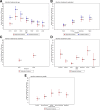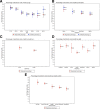Inequities in the incidence and safety of abortion in Nigeria
- PMID: 32133166
- PMCID: PMC7042592
- DOI: 10.1136/bmjgh-2019-001814
Inequities in the incidence and safety of abortion in Nigeria
Abstract
Background: We know little about the frequency, correlates and conditions under which women induce abortions in Nigeria. This study seeks to estimate the 1-year induced abortion incidence and proportion of abortions that are unsafe overall and by women's background characteristics using direct and indirect methodologies.
Methods: Data for this study come from a population-based, nationally representative survey of reproductive age women (15-49) in Nigeria. Interviewers asked women to report on the abortion experiences of their closest female confidante and themselves. We adjusted for potential biases in the confidante data. Analyses include estimation of 1-year induced abortion incidence and unsafe abortion, as well as bivariate and multivariate assessment of their correlates.
Results: A total of 11 106 women of reproductive age completed the female survey; they reported on 5772 confidantes. The 1-year abortion incidence for respondents was 29.0 (95% CI 23.3 to 34.8) per 1000 women aged 15-49 while the confidante incidence was 45.8 (95% CI 41.0-50.6). The respondent and confidante abortion incidences revealed similar correlates, with women in their 20s, women with secondary or higher education and women in urban areas being the most likely to have had an abortion in the prior year. The majority of respondent and confidante abortions were the most unsafe (63.4% and 68.6%, respectively). Women aged 15-19, women who had never attended school and the poorest women were significantly more likely to have had the most unsafe abortions.
Conclusion: Results indicate that abortion in Nigeria is a public health concern and an issue of social inequity. Efforts to expand the legal conditions for abortion in Nigeria are critical. Simultaneously, efforts to increase awareness of the availability of medication abortion drugs to more safely self-induce can help mitigate the toll of unsafe abortion-related morbidity and mortality.
Keywords: abortion; measurement; survey.
© Author(s) (or their employer(s)) 2020. Re-use permitted under CC BY-NC. No commercial re-use. See rights and permissions. Published by BMJ.
Conflict of interest statement
Competing interests: None declared.
Figures


Similar articles
-
Social network-based measurement of abortion incidence: promising findings from population-based surveys in Nigeria, Cote d'Ivoire, and Rajasthan, India.Popul Health Metr. 2020 Oct 19;18(1):28. doi: 10.1186/s12963-020-00235-y. Popul Health Metr. 2020. PMID: 33076922 Free PMC article.
-
Induced abortion incidence and safety in Côte d'Ivoire.PLoS One. 2020 May 7;15(5):e0232364. doi: 10.1371/journal.pone.0232364. eCollection 2020. PLoS One. 2020. PMID: 32379768 Free PMC article.
-
Induced Abortion Incidence and Safety in Rajasthan, India: Evidence that Expansion of Services is Needed.Stud Fam Plann. 2020 Dec;51(4):323-342. doi: 10.1111/sifp.12140. Epub 2020 Dec 3. Stud Fam Plann. 2020. PMID: 33270920
-
Novel approaches to estimating abortion incidence.Reprod Health. 2019 Apr 18;16(1):44. doi: 10.1186/s12978-019-0702-0. Reprod Health. 2019. PMID: 30999917 Free PMC article. Review.
-
Unsafe abortion and its ethical, sexual and reproductive rights implications.West Afr J Med. 2011 Jul-Aug;30(4):245-9. West Afr J Med. 2011. PMID: 22669827 Review.
Cited by
-
Menstrual regulation: examining the incidence, methods, and sources of care of this understudied health practice in three settings using cross-sectional population-based surveys.BMC Womens Health. 2023 Feb 17;23(1):73. doi: 10.1186/s12905-023-02216-3. BMC Womens Health. 2023. PMID: 36804033 Free PMC article.
-
An Assessment of Third-Party Reporting of Close Ties to Measure Sensitive Behaviors: The Confidante Method to Measure Abortion Incidence in Ethiopia and Uganda.Stud Fam Plann. 2021 Dec;52(4):513-538. doi: 10.1111/sifp.12180. Epub 2021 Nov 11. Stud Fam Plann. 2021. PMID: 34762302 Free PMC article.
-
Estimating induced abortion incidence and the use of non-recommended abortion methods and sources in two provinces of the Democratic Republic of the Congo (Kinshasa and Kongo Central) in 2021: results from population-based, cross-sectional surveys of reproductive-aged women.Sex Reprod Health Matters. 2023 Dec;31(1):2207279. doi: 10.1080/26410397.2023.2207279. Sex Reprod Health Matters. 2023. PMID: 37216481 Free PMC article.
-
Factors influencing unintended pregnancy and abortion among unmarried young people in Nigeria: a scoping review.BMC Public Health. 2024 Jun 4;24(1):1494. doi: 10.1186/s12889-024-19005-8. BMC Public Health. 2024. PMID: 38835026 Free PMC article.
-
Drug sellers' knowledge and practices, and client perspectives after an intervention to improve the quality of safe abortion care outside of formal clinics in Nigeria.BMJ Sex Reprod Health. 2022 Jan;48(e1):e44-e52. doi: 10.1136/bmjsrh-2020-200955. Epub 2021 May 10. BMJ Sex Reprod Health. 2022. PMID: 33972396 Free PMC article.
References
-
- Henshaw SK, Singh S, Oye-Adeniran BA, et al. . The incidence of induced abortion in Nigeria. Int Fam Plan Perspect 1998;24:156–64. 10.2307/2991973 - DOI
-
- Singh S, Remez L, Sedgh G, et al. . Abortion worldwide 2017: uneven progress and unequal access abortion worldwide 2017: uneven progress and unequal access. 2018.
Publication types
MeSH terms
LinkOut - more resources
Full Text Sources
Medical
